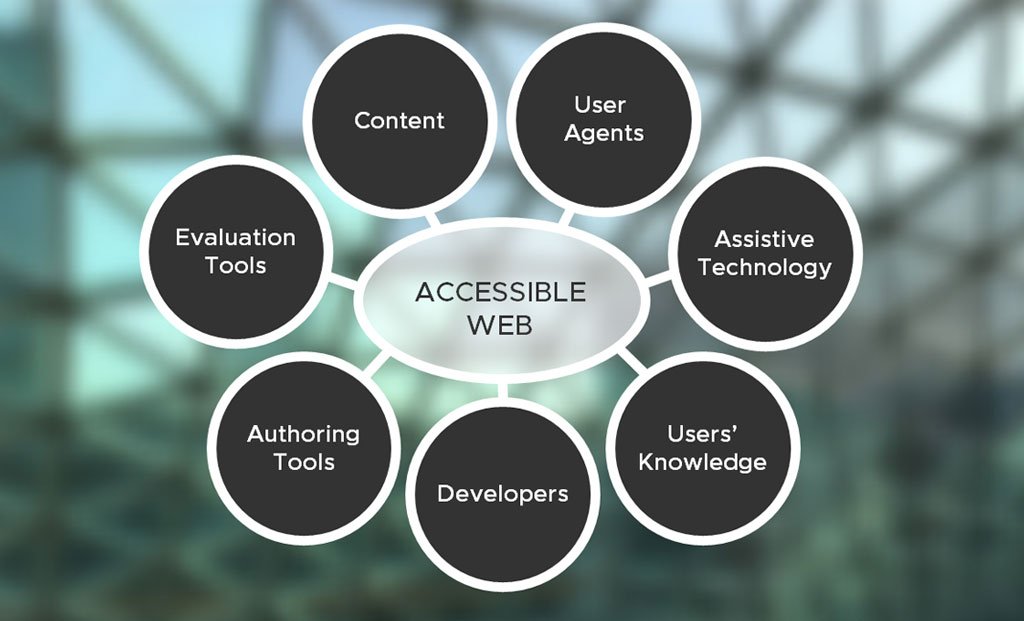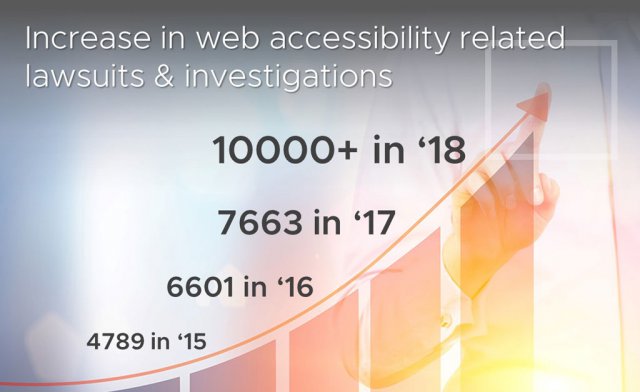And why should I care about it?
Much like a physical location, your website should be accessible to everyone. Due to a rapid increase in legal actions over the past few years, ADA Compliance for websites and applications is rapidly becoming a common standard for businesses and organizations to act in accordance with these accommodations -- and in some cases it’s even mandatory. Unfortunately, the specific requirements to meet compliance tend to be a bit vague and confusing to wrap your head around, but it’s important to understand how it impacts your business. Let's start with the basics.
What is Website Accessibility?
Web Accessibility basically means developing websites, web applications and web authoring tools to be usable to as many people as possible. It helps people with disabilities to understand, navigate, and interact with the Web. It also benefits those with changing abilities due to aging or temporary ailments. It encompasses all disabilities that affect access to the web including; visual, auditory, physical, speech, cognitive, and neurological disabilities.
Most likely you have experienced a website that fails to meet some of the basic guidelines for web accessibility.
- trying to read text that is too small
- struggling to click a tiny button on your smartphone screen
- attempted to play a video file that you can’t hear
There are many ways that users might be impeded by an inaccessible website. Common accessibility and usability errors that plague many websites and people.
- color contrast
- text size
- page organization
- keyboard interactivity
For users that are completely blind, accessibility includes making provisions for all content and the interactivity on a web page to be understandable to a screen reader, a program that reads the contents of a webpage to the user and allows them to interact with the website. Some users may be unable to use a mouse, so using only a keyboard they need to scroll, navigate and interact within a website.

Understanding how the ADA relates to websites.
The ADA’s relationship with websites has been a complicated and often confusing story. Currently, the ADA does not explicitly address online compliance, even after undergoing several amendments in the far more web-oriented era of 2008. With no specific coverage under the law, it usually falls to the courts to determine how ADA standards apply to websites—or whether they do at all.
The most comprehensive guidelines for building and maintaining accessible web sites are the Web Content Accessibility Guidelines (WCAG), published by the W3C. The first version, WCAG 1.0, was drafted back in 1999. WCAG 2.0 was published in 2008 and WCAG 2.1 recommendations were published in June 2018, including 17 new success criteria. They outline the four guidelines of web accessibility:
Accessibility issues are categorized in four distinct groups under WCAG guidelines. Conveniently, they can be summed up with the acronym P.O.U.R.
Perceivable – can all users perceive the content on the page?
Operable – can all users interact with the page?
Understandable – can all users understand the content on the page?
Robust – can the content be interpreted by a wide variety of programs and devices, including screen readers?
What are the Levels of compliance?
The WCAG guidelines break down accessibility issues and recommendations into three levels.
A - Starting with Level A, meeting the minimum requirements for accessibility, addressing the most urgent issues and problems that can severely limit a disabled visitor’s ability to navigate or use a website.
AA - The intermediate, Level AA compliance, addresses some more complex functionality issues to help ensure the full user experience will accommodate the needs of with a wider range of disabilities by providing guidance on color contrast ratios, error identification, etc. (Level AA is typically the general standard that most commercial websites should strive to achieve.)
AAA - Level AAA is the highest standard, which requires refining and expanding on issues identified as Level A and AA to meet all of the accessibility requirements. This advanced level of compliance can be a challenging, costly endeavor for some organizations.
It is essential that several different components of web development and interaction work together in order for the web to be accessible to people with disabilities.

Why is Web Accessibility so important now?
Accessibility has been an important web standard for a while now, however, with the web becoming an increasingly important resource in our daily lifestyle, it is imperative that it provides equal access and equal opportunity to people with disabilities. Additionally, accessible websites can help improve SEO and the overall user experience for all users.
An accessible website is often the one of the easiest and most effective ways to do business with many people with disabilities. The W3C Web Accessibility Initiative (WAI) develops standards and support materials to help you understand and implement accessibility. Some of the industries that have the greatest impact on this initiative include: education, employment, government, commerce, health care, recreation, hospitality and more.
Even though the WCAG have been established for a long time, most stakeholders of web initiatives are still not putting enough emphasis on the proper implementation for accessibility. This neglect has been brought to the forefront in recent years by a series of lawsuits filed under Title III of the Americans with Disabilities Act (ADA). Title III requires public spaces and commercial facilities to be designed and built so that users with disabilities can enjoy equal access to these facilities. Although the law was originally written with physical spaces in mind, the prevalence of web-based activities including shopping, online learning and searching for job opportunities has brought focus to ADA requirements for many organizations.
Additional Benefits of Web Accessibility
Avoiding a lawsuit or investigation isn’t the only reason to work on improving web accessibility. Focusing on web accessibility will add value to your web presence and also comes with other additional benefits.
Better Usability
When implemented properly web accessibility makes content more usable for all users who are new to the particular website or application. It helps people who are less experienced and not confident using computers or interacting with the web. It will improve the user experience for mobile device users who are seeing it on smaller screens, especially if they are in a hurry or distracted. It will help ensure that content is more visible in different lighting conditions, such as sunlight and glare. The highly organized content will be easier to read by everyone, including those who do not have specific visual conditions. People with temporary limitations, such as a broken arm, will be able to use an accessible website. Streamlining content makes is easier to skim, less confusing and get an overview of the information for everyone, regardless of skills.
Enhanced SEO
The same practices that ensure all content is perceivable and understandable to disabled users will also help improve your organic Search Engine Optimization (SEO). Making your web content easier for people to understand, will inevitably make it easier for Google’s robots to crawl and properly index your site.
Many accessibility guidelines focus on providing text-based alternatives to content that is available in video or audio, which allows this content to be visible to screen readers and search engines alike. The guidelines also encourage the use of proper page organization to help users best understand the layout and content of a page, which coincidentally helps search engines understand the content of a page better.
The Takeaway - Having A Common Goal
Web accessibility is more important than ever before and will only increase in importance as the web continues to integrate into our daily routines. The main goal of this initiative is to reward proactive thinking and implementation, and those organizations who embrace this mentality will be able to generate loyalty and good faith with their users, serve the larger market, and avoid the bad press associated with a lawsuit or investigation.
Let’s all work together to help make the web better... for everyone.
Please contact us to find out if your website meets ADA compliance based on the current WCAG 2.1 recommendations.


